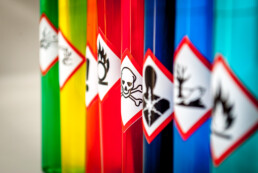As we have detailed in previous posts, the labelling of chemicals for industry has been changing in recent years. In this sense, the GHS (Globally Harmonised System) has universalized a series of symbols to warn users of the hazards that may be associated with the chemical substance provided by third party packaging services. What pictograms can we find?
The list of pictograms established by the GHS regulation
The nine GHS graphic symbols are explained below.
GHS01. Explosive substances
This symbol warns of physical hazards when handling explosive substances which can be released by sparks, heat, friction, etc. Ammonium dichromate or dynamite are some examples.
GHS02. Flammable substances
These products have the risk of combustion, so they must remain hermetically sealed when not in use and may never be stored near acids.
GHS03. Oxidising products
This category includes solutions which, in contact with other substances, especially flammable substances, produce a strong exothermic reaction. They should be stored away from other chemical products, especially flammable ones.
GHS04. Compressed or liquefied gases
Cylinder pressure makes all compressed gases hazardous. However, there are flammable and flammable and toxic, non-toxic, etc. Moreover, given their varied characteristics, so are their hazards and reactions.
GHS05. Corrosive products
These are preparations which, in contact with living tissues, may have a destructive action on them. Preventive measures should therefore be taken for each product and in the circumstances in which it is used, paying particular attention to the manufacturer’s instructions. In addition, personnel handling these products must be properly trained. We should bear in mind that solutions such as caustic soda are very dangerous.
GHS06. Toxic substances
Particular caution should be taken with these preparations which, through inhalation, ingestion or skin penetration, can cause acute or chronic effects and, in the worst case, death. Therefore, their use is only recommended when there are no other products designed for the same purpose that pose lesser risks.
When mixing or transferring products, extreme precautions should be taken, carrying out these tasks in well ventilated areas, wearing personal protective clothing, etc.
GHS07. Irritant products
Such preparations are not corrosive, but may cause inflammatory reactions if skin or mucous membranes are exposed to them. Among other indications, the manufacturers warn that containers containing this pictogram should be hermetically sealed after use, or used in environments with eye wash and shower facilities for immediate action in case of contact.
GHS08. Carcinogens, mutagens and teratogens
Inhalation, ingestion or skin penetration of such substances may cause cancer or increase the risk of cancer. It is therefore essential to reduce exposure to these agents as much as possible and to replace them with other products that are less hazardous to health.
In addition, the number of employees having to work with such solutions should be limited, but also the risk area where the product is located or handled with appropriate signage.
GHS09. Environmentally hazardous products
These substances, in contact with the environment, can cause serious damage to the ecosystem, which is why it is essential not to pour this type of waste down pipes and drains.
Finally, we would like to remind you that at Solimix we have been meeting all quality standards in our packaging services for third parties since 1978. Call us!


